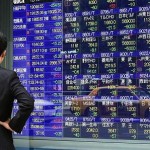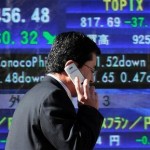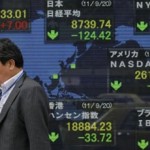Asia markets rise; Japanese yen maintains 111 handle versus dollar

Asian markets were mixed Monday, with Japanese shares losing ground on the back of a lower dollar/yen pair, which has hovered at the 111 level since Friday.
Australia’s ASX 200 was up 0.64 percent, while Japan’s Nikkei 225 gave up gains to trade lower 0.34 percent and the Kospi in South Korea was near flat.
Down Under, the benchmark index was boosted by the financials sub-index, up 0.96 percent, with the country’s so-called Big Four banks -ANZ, Commonwealth Bank of Australia, Westpac and NAB – adding between 0.9 and 1.29 percent.
In Japan, data from Bank of Japan (BOJ) showed that its decision to adopt negative interest rates in late January has not convinced Japanese companies that inflation in the country will take off.
Additional data released on Monday as part of the BOJ’s Tankan survey for March showed that companies expected prices to increase on average 0.8 percent a year from now, lower than their previous expectations of a 1 percent increase earlier this year. Firms expect prices to go up 1.1 percent over three years, lower than their previous expectations of a 1.3 percent rise. The Tankan survey was originally released on Friday.
The yen, which has strengthened since the BOJ’s decision to introduce negative rates in January, was at the 111 handle against the dollar on Monday; as of 11:56 a.m. HK/SIN, the dollar/yen pair traded at 111.45.
Stephen Innes, a senior FX trader at OANDA, said in a note the pair’s struggle was due to the “haven appeal for dollar weakness” and had little to do with yen strength.
Major Japanese exporters were lower, with shares of Toyota down 2.79 percent, Nissan off 3.4 percent and Honda lower by 1.78 percent. A stronger yen is a negative for exporters as it affects their overseas profits when converted into local currency.
U.S. crude futures retreated during Asian hours, down 1.11 percent at $36.38 a barrel as of 11:57 a.m. HK/SIN, after finishing down 4 percent on Friday. Global benchmark Brent futures were off 0.91 percent to $38.32 a barrel, after finishing down 2.34 percent on Friday.
Evan Lucas, market strategist at IG, said in a morning note that Saudi Arabia, as the largest producer in the Organization of the Petroleum Exporting Countries (OPEC), is still dominating negotiations around the production freeze accord.
Saudi Arabia’s deputy Crown Prince Mohammed bin Salman made remarks last week that cast fresh doubts over the ability of world oil producers to agree to an output freeze at their meeting in Qatar on April 17. The prince was reported as saying the kingdom would not participate in a freeze if Iran and other major producers, both OPEC and non-OPEC, do not join the program.
Bin Salman’s remarks helped to knock 4 percent off the price of U.S. crude Friday.
“There has not been one proposal yet that Iran has remotely entertained,” said Lucas, adding Iran was still producing 25 to 30 percent below its pre-sanctions levels. “[That is] the level Iran wants to reach before entertaining any form of ‘freeze.'”
Iran’s Minister of Petroleum, Bijan Zanganeh, said over the weekend that the country is exporting above 2 million barrels of oil and gas condensates a day, according to the Shana news agency.
Energy plays in Asia were mostly lower on Monday, with shares ofSantos down 3.19 percent and Woodside Petroleum down 1.71 percent, while Inpex erased gains to trade down 0.65 percent.
Markets in China, Hong Kong and Taiwan are closed today.
On Friday, figures showed that U.S. nonfarm payrolls rose 215,000 in March, beating expectations for 205,000 jobs. The U.S. unemployment rate was at 5.0 percent, the first month-over-month increase since May 2015.
Major U.S. indexes closed higher on Friday, with the Dow Jones industrial average up 0.61 percent, the S&P 500 higher by 0.63 percent and the Nasdaq composite ending up 0.92 percent.
Source: CNBC




























